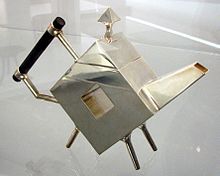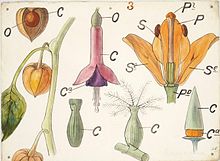Christopher Dresser
Christopher Dresser | |
|---|---|
 | |
| Born | 4 July 1834 Glasgow, Scotland |
| Died | 24 November 1904 (aged 70) |
| Occupation | Designer |
Christopher Dresser (4 July 1834 – 24 November 1904) was a British
Biography

Dresser was born in

From this early date his design work widened to include carpets, ceramics, furniture, glass, graphics, metalwork, including silver and electroplate, and textiles printed and woven. He claimed to have designed "as much as any man" at the International Exhibition London 1862. As early as 1865 the Building News reported that in the early part of his career he had been active as a designer of wallpapers, textiles and carpets, and the most active revolutioniser in the decorative art of the day.[2] He wrote several books on design and ornament, including The Art of Decorative Design (1862), The Development of Ornamental Art in the International Exhibition (1862), and Principles of Design (1873), which was addressed in the preface to "working men". In 1899 The Studio magazine found it was possible to quote this book "page after page and not find a line, scarcely a word, that would not be endorsed by the most critical member of the Arts and Crafts Association today." In effect Dresser set the agenda adopted by the Arts and Crafts movement at a later date.[3]
In 1873 he was requested by the American Government to write a report on the design of household goods.[3]
En route for Japan in 1876 he delivered a series of three lectures in the Philadelphia Museum and School of Industrial Art and supervised the manufacture of wallpapers to his design for Wilson Fennimore. He was commissioned by Messrs Tiffany of New York to form a collection, whilst in Japan, of art objects both old and new that should illustrate the manufactures of that country.[2]
In 1876, the British Government appointed Dresser as an emissary to Japan and sent him to visit Japan after he became associated with Japanese art in 1862, and made a number of Japanese business associates such as Kiritsu Kosho Kaisha, in the years following.[4] In four months in 1876–1877 Dresser travelled about 2000 miles in Japan, recording his impressions in Japan, its Architecture, Art and Art-Manufactures. He represented the South Kensington Museum whilst in Japan, and was received at court by the Emperor, who ordered Dresser to be treated as a guest of the nation – all doors were open to him. He was requested by the Japanese Government to write a report on 'Trade with Europe'. His pioneering study of Japanese art is evident in much of his work which is considered typical of the Anglo-Japanese style.
From 1879 to 1882 Dresser was in partnership with Charles Holme (1848–1923) as Dresser & Holme, wholesale importers of Oriental goods, with a warehouse at 7 Farringdon Road, London.[5]

Between 1879 and 1882, as Art Superintendent at the
Some of Dresser’s metalwork designs are still in production, such as his oil and vinegar sets and toast rack designs, now manufactured by Alessi. Alberto Alessi goes so far as to say Dresser 'knew the techniques of metal production better than any designer who has come to Alessi'.[7]
One of his Old Hall designs is thought to have inspired Alan Garner's 1967 novel The Owl Service.[8]
Dresser died in Mulhouse in 1904, during a business trip in which he intended to sell designs to local industries.[9]
Gallery
-
Toast Rack (1881)
-
Pitcher (c. 1881)
-
Bottle vase for Linthorpe Art Pottery (c. 1882)
-
Soup tureen and ladle (1888)
-
Pitcher
-
Glass dish for Couper & Sons
Partial bibliography

- Unity in Variety, as Deduced from the Vegetable Kingdom. London: James S. Virtue. 1860.
- The Rudiments of Botany, Structural and Physiological. London: James S. Virtue. 1859.
- Popular manual of Botany. 1860.
- The Art of Decorative Design. Day & Son. 1862.
- Development of Ornamental Art in the International Exhibition (1862)
- General Principles of Art, Decorative and Pictorial, with hints on colour, its harmonies and contrasts (1868)
- Principles of Decorative Design (1873)
- Studies in Design (1875)
- Japan, its Architecture, Art and Art-Manufactures (1882)
- Modern Ornamentation (1886)
References
- – via JSTOR.
- ^ ISBN 978-0-7148-2952-4.
- ^ a b Morley, Christopher (2010). Dresser's Decorative Design. B.B. Cargin. p. 256.
- ^ Hannah Sigur (2008). The Influence of Japanese Art on Design. Gibbs Smith. p. 86.
- ^ "Christopher Dresser". Archived from the original on 13 December 2014. Retrieved 8 December 2014.
- ^ "What's New - The Christopher Dresser Project". Archived from the original on 19 March 2016. Retrieved 18 February 2019.
- ISBN 978-0-8478-4906-2.
- ^ "Benefactors – Chris Lynch". The Blackden Trust. Archived from the original on 30 September 2020. Retrieved 18 February 2019.
- ^ Bernard Jacqué, "The Death of Christopher Dresser in Mulhouse", Papers of the Symposium held jointly by the Victoria and Albert Museum and the Decorative Arts Society 18 October 2004 (2005), pp. 97-102, The Decorative Arts Society
Further reading
- Flanders, Judith (2004). Inside the Victorian Home: A Portrait of Domestic Life in Victorian England. W.W. Norton. ISBN 978-0-393-05209-1.
- Halen, Widar (1990). "Christopher Dresser and the "Modern English" Style: His Later Designs for Wallpapers and Hangings". The Journal of the Decorative Arts Society 1850 - the Present (14): 10–15. JSTOR 41809171.
- Durant, Stuart. Christopher Dresser. 1993
- Snodin, Michael; Styles, John (2001). Design & the decorative arts: Britain, 1500-1900. V&A Publications. ISBN 9780810965867.
- Whiteway, Michael (2004). Christopher Dresser: A Design Revolution. V&A Publications. ISBN 978-1-85177-428-9.
- Lyons, Harry (1999). Ch. Dresser: People's Designer, 1834-1904, Exhibition by New Century, 2nd-19th June 1999. Alastair Carew-Cox. ISBN 978-0-9532801-1-7.
- Emil Fonfoneata, Exhibition Catalogue of Christopher Dresser (1834–1904) Pioneer of Modern Design, 13 October 2007 – 13 January 2008 – Design Museum Gent – Belgium






